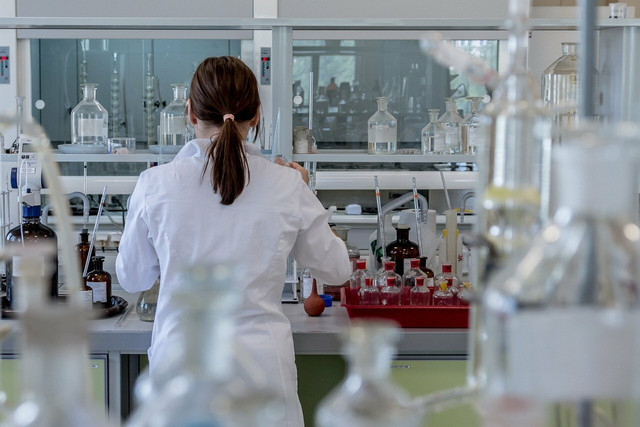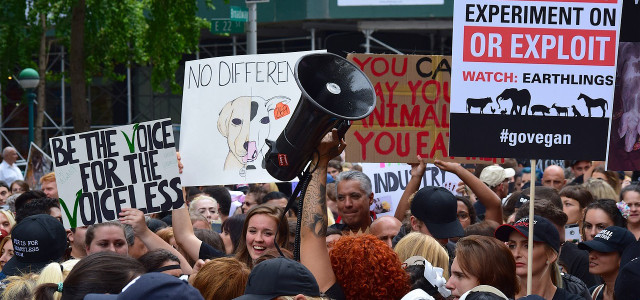We know it's bad. But how much do we actually know about animal testing in the US? Is it a thing of the past, or does it continue to lurk behind our favorite products?
“The greatness of a nation and its moral progress can be judged by the way its animals are treated.”
– Mahatma Gandhi
Animal testing has been ubiquitous in human society for thousands of years. As far back as the neolithic era, experiments have been performed on living animals for the sake of science. It has taken place throughout history’s greatest civilizations — from Ancient Greece, medieval China and Industrial England, all the way to the present day.
What constitutes “testing” has varied tremendously. From simple dissection and surgical experiments, animal testing has evolved into a limitless array of harmful and terrifying procedures, including blood experiments, repeated suffocation, imposed blindness and all manner of gene mutilations.

(Foto: CC0 / Pixabay / jarmoluk)
Of course, these experiments have largely been conducted in the name of science. It would be remiss to understate the incredible advancements in human and animal medicine that have come about thanks to animal testing. For one thing, the practice has saved many endangered species. For another, in many cases, many treatments — including vaccines — were initially developed with animals specifically in mind.
But, overwhelmingly, animals have been used to create treatments for humans. In many cases, treatments go through several stages of animal testing. For example, in 1960, American surgeon Albert Starr pioneered a surgery to successfully replace human heart valves after a series of surgical advances in dogs, using valves made from pig heart valves. This surgery replaces faulty heart valves, a previously fatal condition, for over 300,000 people each year.
Leprosy, cancer, AIDS, organ transplants, vaccines, Alzheimer’s, and Multiple Sclerosis are all researched using animal testing. It is almost impossible to imagine a world where our medical advancements could have come about without first testing on animals.
This is because testing on humans is typically only allowed once a treatment has been shown to work on animals. The contentious ethical justification is that “society deems it unethical to use that drug or technique first in human beings because of the possibility that it would cause harm rather than good.”
In essence, that means it matters more if scientific or medical experimentation harms a human than an animal. This reasoning understandably attracts much debate and fierce critique from animal rights activists.
How big is the problem?
In the US and the EU, all drugs must be tested on animals before human trials can begin — though the EU calls for alternatives to be used wherever possible. In the US alone, the figure of vertebrate animals used for research, education and testing is estimated at between 17 to 22 million per year. While this figure is undoubtedly high, it represents less than a single percent of the number of animals killed for food annually.
Is the Problem Getting Better?
Firstly, not everyone in America believes that animal testing is wrong. However, more and more people are changing their minds. One 2018 survey found that roughly 47 percent of the population approved of the practice, down from 65 percent in 2001.
Proponents, including scientists and researchers, believe that animal testing is necessary for the development of essential treatments and that ethical guidelines are followed strictly in this country. However, opposition to animal testing continues to rise. Supporters of animal testing square the blame for the demise in public opinion largely on the secretive nature of labs, which has played into the hands of animal rights activists, who see the lack of transparency as necessarily sinister.
In addition, more research is coming to the fore regarding the limitations of animal testing. One recent study found that animal testing was particularly bad at predicting toxicity in humans taking novel drugs. In fact, out of 93 serious adverse outcomes in humans during final-stage drug testing in one study, only 19 percent were identified in preclinical animal studies. So, we’re putting animals through these tests, only to find out that they weren’t that useful in the first place.
Labs conducting animal testing continue to go on the offensive. They are changing tack to try and stem the negative downturn of public opinion in the country. Some sectors are doing more than others to reduce animal use. And many believe that, as technology advances, animal testing will become less and less necessary. While many drugs are currently impossible to develop without animal testing, the use of animals in many areas of life-science research is on the decline.
How Can I Tell if Products Have Been Tested on Animals or Not?



(Foto: CC0 / Pixabay / StockSnap)
Watch out for wording on the packaging. That said, do your own research about what the terms really mean and whether they’re regulated or not. Companies have sneaky ways of claiming to be cruelty-free when they’re actually not. Some state “we don’t test our products on animals,” but use another companies to do testing on their behalf. Likewise, the product itself may not have been tested on animals, but the individual ingredients likely have been.
One safe bet is to take a look at Leaping Bunny. Their program is similar to the Fairtrade certification in that it certifies products and companies that adhere to specific standards, in this case, regarding animal cruelty. Their logo is internationally recognized, and there’s even an app you can download to check products on the go.
Read more:
- Leaping Bunny: The Cruelty-Free Label
- Speciesism: What Does It Mean and How Can We Prevent It?
- Are Cigarettes Vegan? Why You Might be Smoking Animal Products
Do you like this post?






